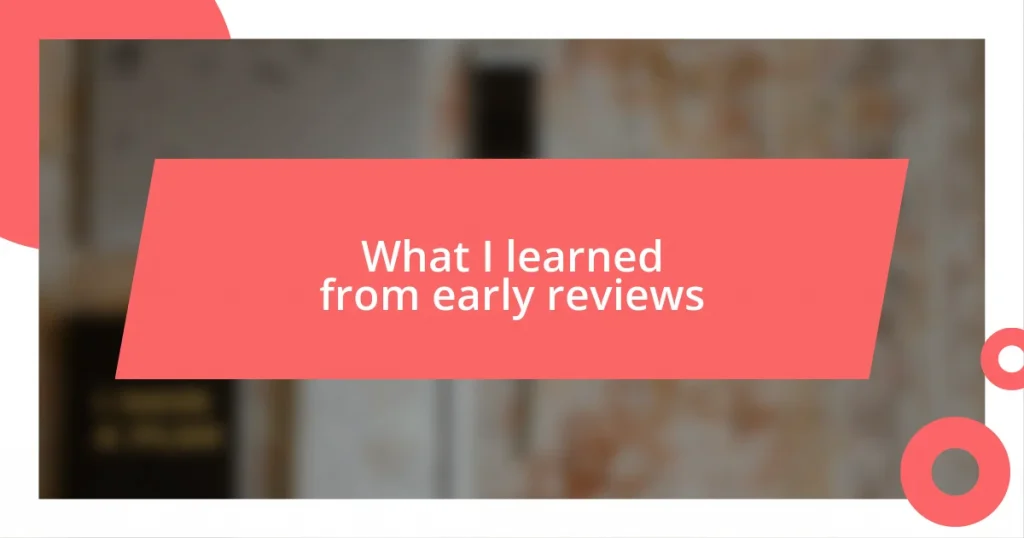Key takeaways:
- Box office patterns reveal audience preferences influenced by factors such as release timing, demographics, and social media trends.
- Star power, effective marketing, and competition significantly impact a film’s box office success, often overshadowing smaller productions.
- Analyzing historical data and audience sentiment helps forecast future box office performance and understand shifts in viewing behavior.

Understanding Box Office Patterns
Box office patterns offer a fascinating glimpse into audience behavior and market trends. I remember analyzing the release schedules of blockbuster films and noticing how certain genres seemed to thrive during specific seasons—like summer for action-packed movies. Isn’t it interesting to think about how our collective mood can influence what’s on the big screen?
Often, a solid understanding of box office performance involves recognizing trends over time. I can still recall the excitement when a film opened strong on its first weekend, only to see it experience a steep drop in the following weeks. It made me wonder: what causes audiences to flock to a film initially, only to lose interest? This pattern often reflects factors like word-of-mouth, critical reviews, and even social media buzz.
Moreover, I’ve found that geographical elements play a significant role in shaping box office results. For instance, a film that resonates in urban areas may not perform as well in rural communities. I once watched a regional film gain unexpected traction in my hometown, prompting me to reflect: how do cultural nuances influence our movie-watching habits? These insights showcase just how complex and layered box office patterns can be.

Identifying Recurring Trends
Identifying trends in box office performance requires careful observation of data over time. I vividly remember poring over weekly gross receipts, where I began to spot patterns that repeated year after year. For instance, certain horror films always tend to debut around Halloween, capitalizing on audiences’ cravings for frights during the spooky season. These moments of realization opened my eyes to how cyclic behavior in release timing can dramatically influence a film’s reception.
To identify recurring trends, consider these factors:
– Release Timing: Holidays and summer months often yield different genres.
– Audience Demographics: Specific age groups lean towards particular themes or styles.
– Critics’ Reception: The influence of early reviews on box office performance can’t be overstated.
– Social Media Trends: Viral moments on platforms like TikTok can drive attendance.
– Cultural Events: Linkages between real-world events and timely film themes often shape the audience’s mood.
Reflecting on these insights has been fascinating. I remember a friend excitedly sharing TikTok videos related to a romantic comedy, which led us to watch it on opening weekend. It wasn’t just curiosity—it was a community experience. Recognizing these interconnected factors can transform our understanding of box office trends, revealing how our emotions interplay with cinematic choices.

Factors Influencing Box Office Success
Understanding what influences box office success can be quite engaging. In my experience, I’ve noticed that a film’s star power plays a pivotal role. When a beloved actor headlines a movie, it often drives fan loyalty, pulling in crowds eager to see their favorite personalities on screen. I recall going to see a movie solely because my favorite actress was in it, despite not knowing much about the plot. This behavior shows just how much star appeal can shift the needle at the box office.
Another crucial factor is marketing strategy. Films that employ clever advertising and extensive promotional campaigns tend to perform better. I remember the buzz around a certain superhero film that flooded social media with trailers and teasers. The hype built anticipation, and on opening weekend, theaters were packed with excited fans ready to experience it. This kind of effective marketing creates a conversation that fuels attendance and creates a sense of excitement among potential viewers.
Lastly, competition can’t be overlooked. The release of another blockbuster at the same time can spell disaster for a less popular film. A friend shared their hesitation in seeing a smaller indie film when a widely anticipated sequel opened the same weekend. The rush for the big title overshadowed the smaller contender, highlighting how fierce competition can impact box office results significantly.
| Factors | Impact on Box Office |
|---|---|
| Star Power | Increases initial attendance due to fan loyalty. |
| Marketing Strategy | Creates buzz and anticipation, driving viewer turnout. |
| Competition | Can overshadow smaller films, affecting their performance. |

Analyzing Historical Data
Analyzing historical data in the box office realm reveals not just numbers but stories and emotions tied to our viewing experiences. I recall digging into box office reports over several years, and it struck me how genres seem to ebb and flow like tides. For instance, during economic downturns, audiences gravitated toward lighter, feel-good films, providing a necessary escape. Have you ever felt that pull towards a comforting film during tough times? It’s fascinating to see how these financial climates inform our choices at the cinema.
On a deeper level, examining these historical patterns allows us to connect the dots between societal shifts and film success. I remember analyzing how movies reflecting social movements—like those advocating for equality—experienced spikes in attendance during pivotal moments in history. Watching peers come together for screenings of films that echoed their values was a powerful experience that illustrated how art can galvanize communities. Doesn’t it make you wonder how many lives a single film can touch, just by resonating with the right moment?
Data also reveals nuances in audience behavior across different eras. I often found myself pondering why certain films that once dominated the box office might not hold up years later. When I explained this phenomenon to a friend, we both laughed about our childhood favorites that, despite being box office hits, seem cringeworthy today. Are our evolving tastes a reflection of our growth? This dynamic nature of audience preferences is what makes analyzing historical data so captivating; it opens a window into not only past trends but also into who we are as ever-changing viewers.

Examples of Successful Patterns
When I think about successful box office patterns, the trend of holiday releases pops into my mind. Films like “Star Wars” or animated features from Disney often debut around the holiday season, tapping into the collective festive spirit. I remember family outings during Christmas where we’d gather at the theater, and the joy of sharing those cinematic moments created lasting memories. Don’t you agree that a shared experience can bring families even closer?
Another effective pattern I’ve noticed is the phenomenon of sequels and franchises. Just think of the Marvel Cinematic Universe; each new installment feels like an event. I remember the excitement I felt waiting for “Avengers: Endgame” after becoming emotionally invested in the characters over the years. That anticipation wasn’t just for the movie itself; it was for the communal experience with other fans. How powerful is it that a well-crafted narrative can foster a sense of belonging among viewers?
Finally, limited release films experiencing breakout success by word of mouth is a captivating pattern. I once stumbled upon an indie film that had only played in a few theaters, but after friends praised it relentlessly, I decided to catch it. The intimate setting and powerful storytelling left me in awe. It struck me how genuine recommendations can spark curiosity and drive audiences to seek out films they might otherwise overlook. Have you ever felt that urge to dive deep into a lesser-known title because of someone’s passionate endorsement? It’s amazing how connections and conversations influence our choices at the box office.

Applying Insights to New Releases
When applying insights to new releases, I can’t help but recall my excitement for a fresh title that had been building buzz online. The marketing team skillfully tapped into nostalgic elements, reminiscent of films from my childhood, sparking my curiosity. Have you ever found yourself drawn to a movie simply because it echoes something familiar? This connection often translates into ticket sales, as audiences seek out what resonates with their past experiences.
I’ve noticed that timing can make a significant difference in how a new film is received. I remember the anticipation surrounding a summer blockbuster last year, perfectly timed with school vacations. It was fascinating to see families flock to theaters, craving that shared experience on hot summer nights. Isn’t it interesting how strategic timing can align with our lives in such relatable ways?
Furthermore, engaging with audiences through social media has become crucial for new releases. I’ve participated in discussions where fans dissect trailers and share theories—it’s like being part of a movie club. This communal excitement can lead to a surge in ticket sales as anticipation builds. Isn’t it remarkable how digital conversations can create a communal buzz that translates into real-world attendance? It’s an ever-evolving landscape, and I love witnessing how these insights shape the films we embrace.

Forecasting Future Box Office Performance
Forecasting future box office performance requires a blend of data analysis and understanding audience trends. I remember digging into box office reports for a highly-anticipated sequel. The numbers from the previous films were promising, and it made me wonder—can the excitement really be calculated? The buzz around the franchise certainly suggested a strong opening weekend, but the real test was whether that initial surge would sustain over weeks.
One tool I’ve found invaluable in predicting performance is social media sentiment analysis. I recall scrolling through Twitter before a film’s release and seeing a wave of emotions—thrill, nostalgia, even some apprehension. Analyzing these shifts in sentiment made me realize how passionate audiences can shape box office outcomes. Have you ever thought about how quickly conversation can go from enthusiastic to skeptical? That fluctuation often foreshadows how well a film will perform after the initial weekend.
Finally, examining historical trends can provide context for future releases. I used to study patterns from past summer blockbusters, noting how competition affected their performance. I remember comparing two films released on the same weekend and how one dominated despite being less critically acclaimed. It raised an intriguing question for me: does hype outweigh quality when it comes to box office success? Reflecting on these elements helps in making educated forecasts, even in an unpredictable industry.















